
Radar is a detection system that uses radio waves to determine the range, angle, or velocity of objects. It can be used to detect aircraft, ships, spacecraft, guided missiles, motor vehicles, weather formations, and terrain. A radar system consists of a transmitter producing electromagnetic waves in the radio or microwaves domain, a transmitting antenna, a receiving antenna and a receiver and processor to determine properties of the object(s). Radio waves from the transmitter reflect off the object and return to the receiver, giving information about the object's location and speed.
Ultra-wideband is a radio technology that can use a very low energy level for short-range, high-bandwidth communications over a large portion of the radio spectrum. UWB has traditional applications in non-cooperative radar imaging. Most recent applications target sensor data collection, precision locating and tracking applications.

Goalkeeper is a Dutch close-in weapon system (CIWS) introduced in 1979. It is an autonomous and completely automatic weapon system for short-range defence of ships against highly maneuverable missiles, aircraft and fast maneuvering surface vessels. Once activated the system automatically undertakes the entire air defense process from surveillance and detection to destruction, including selection of the next priority target.

Starstreak is a British short range man-portable air-defence system (MANPADS) manufactured by Thales Air Defence, in Belfast. It is also known as Starstreak HVM. After launch, the missile accelerates to more than Mach 4, making it the fastest short-range surface-to-air missile in the world. It then launches three laser beam riding submunitions, increasing the likelihood of a successful hit on the target. Starstreak has been in service with the British Army since 1997. In 2012 Thales rebranded the system under the ForceSHIELD banner.

An active electronically scanned array (AESA) is a type of phased array antenna, which is a computer-controlled array antenna in which the beam of radio waves can be electronically steered to point in different directions without moving the antenna. In the AESA, each antenna element is connected to a small solid-state transmit/receive module (TRM) under the control of a computer, which performs the functions of a transmitter and/or receiver for the antenna. This contrasts with a passive electronically scanned array (PESA), in which all the antenna elements are connected to a single transmitter and/or receiver through phase shifters under the control of the computer. AESA's main use is in radar, and these are known as active phased array radar (APAR).

Targeting pods are target designation tools used by ground-attack aircraft for identifying targets and guiding precision guided munitions (PGM) such as laser-guided bombs to those targets. The first targeting pods were developed in conjunction with the earliest generation of PGMs in the mid-1960s.
Command guidance is a type of missile guidance in which a ground station or aircraft relay signals to a guided missile via radio control or through a wire connecting the missile to the launcher and tell the missile where to steer in order to intercept its target. This control may also command the missile to detonate, even if the missile itself has a fuze.

A counter-battery radar is a radar system that detects artillery projectiles fired by one or more guns, howitzers, mortars or rocket launchers and, from their trajectories, locates the position on the ground of the weapon that fired it. Such radars are a subclass of the wider class of target acquisition radars.
Passive radar systems encompass a class of radar systems that detect and track objects by processing reflections from non-cooperative sources of illumination in the environment, such as commercial broadcast and communications signals. It is a specific case of bistatic radar, the latter also including the exploitation of cooperative and non-cooperative radar transmitters.
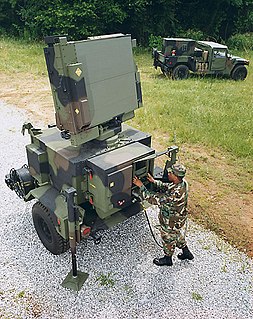
The AN/MPQ-64 Sentinel is a 3D radar used to alert and queue Short Range Air Defense (SHORAD) weapons to the locations of hostile targets approaching their front line forces. The Sentinel radar is deployed with forward area air defense units of the U.S. Army. It is an X-band range-gated, pulse-Doppler radar system. The antenna uses phase-frequency electronic scanning technology, forming sharp 3D pencil beams covering large surveillance and track volume. The radar automatically acquires, tracks, classifies, identifies and reports targets, including cruise missiles, unmanned aerial vehicles, and both rotary- and fixed-wing aircraft. It uses a high scan rate and operates at a range of 40 km (25 mi). The radar is designed with high resistance to electronic countermeasures (ECM). Mounted on a towed platform, it can be positioned remotely from the rest of the unit, operated autonomously and communicate with the Fire Distribution Center (FDC) via wideband fiber-optic link. It can also distribute its data over a SINCGARS radio network.
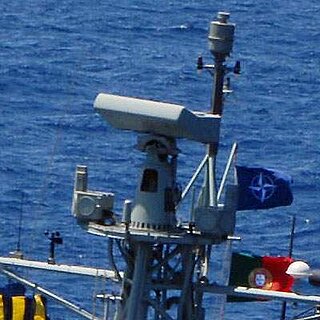
Thales Naval Nederland MW08 is a G-band passive electronically scanned array target indication 3D radar, part of the 3D multibeam 'SMART' family which includes E/F band SMART-S/SMART-S Mk2 and D band SMART-L.
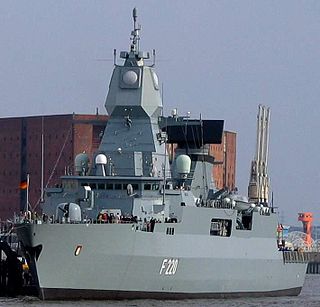
SMART-L is a naval long-range search radar from Thales Nederland, formerly Hollandse Signaalapparaten (Signaal).

The S1850M is a long range passive electronically scanned array(PESA) radar for wide area search. The S1850M is produced by BAE Systems Integrated System Technologies and Thales. It is a modified version of the Thales Nederland SMART-L radar. The S1850M is advertised as being capable of fully automatic detection, track initiation and tracking of up to 1,000 targets at a range of 400 kilometres (250 mi). It is also claimed to be highly capable of detecting stealth targets, and is able to detect and track outer atmosphere objects at short range, making it capable of forming part of a Theatre Ballistic Missile Defence system.

The RBE2 is a multirole radar developed during the 1990s for the French Dassault Rafale combat aircraft.
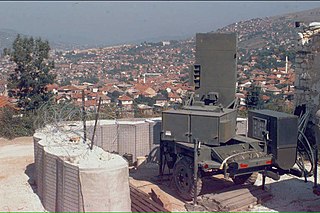
Hughes AN/TPQ-36 Firefinder Weapon Locating System is a mobile radar system developed by Hughes Aircraft Company and manufactured by Northrop Grumman and ThalesRaytheonSystems. The system is a "weapon-locating radar", designed to detect and track incoming artillery and rocket fire to determine the point of origin for counterbattery fire. It is currently in service at battalion and higher levels in the United States Army, United States Marine Corps and Australian Army. Also Turkish Army, Portugal and Ukrainian Army are among the users.
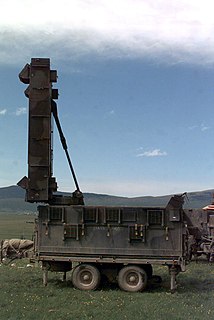
Hughes AN/TPQ-37 Firefinder Weapon Locating System is a mobile radar system developed by Hughes Aircraft Company and currently manufactured by ThalesRaytheonSystems. The system is a long-range version of “weapon-locating radar,” designed to detect and track incoming artillery and rocket fire to determine the point of origin for counter-battery fire. It is currently in service at brigade and higher levels in the United States Army and by other countries. The radar is trailer-mounted and towed by a 2⅓-ton truck. A typical AN/TPQ-37 system consists of the Antenna-Transceiver Group, Command Shelter and 60 kW Generator.
Radar MASINT is a subdiscipline of measurement and signature intelligence (MASINT) and refers to intelligence gathering activities that bring together disparate elements that do not fit within the definitions of signals intelligence (SIGINT), imagery intelligence (IMINT), or human intelligence (HUMINT).

The Swathi Weapon Locating Radar (WLR) is a mobile artillery locating phased array radar developed by India. This counter-battery radar is designed to detect and track incoming artillery and rocket fire to determine the point of origin for Counter-battery fire.
A surface search radar, sometimes more accurately known as a sea-surface search radar or naval surveillance radar, is a type of radar intended primarily to locate objects on the surface of lakes and oceans. They are widely found on civilian ships and even small pleasure craft, in which case they are more commonly known simply as marine radar. They are also widely used on maritime patrol aircraft and naval helicopters. When mounted on an aircraft, they are sometimes known by the British terminology, Air-to-Surface Vessel radar, or ASV for short.














